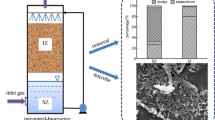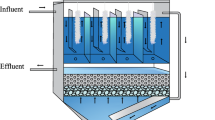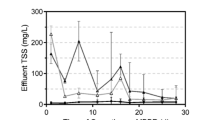Abstract
An integrated-bioreactor, which consisted of a suspended zone and an immobilized zone, was applied to treat gases containing SO2. The removal of SO2 in suspended zone differed slightly from that in immobilized zone. The influences of operational aspects such as SO2 load, temperature, and pH on integrated-bioreactor performance and bacterial community composition were investigated. The synergistic action of the two zones led to effective reduction of SO2, and the total removal efficiencies with the inlet concentration of 91–117 mg/m3, were over 85 % in steady state. Paenibacillus sp. and Lysinibacillus sp. dominated both zones as desulfurization bacteria. Results of polymerase chain reaction-denaturing gradient gel electrophoresis followed by clone library analysis indicated that temporal shifts in bacterial community composition in both zones developed differently. Differences in the concentration of introduced SO2 and supported mode of microorganisms for survival, confirmed that bacterial community composition and abundance significantly differed among individual zones.









Similar content being viewed by others
References
Atanes E, Nieto-Márquez A, Cambra A, Ruiz-Pérez MC, Fernández-Martínez F (2012) Adsorption of SO2 onto waste cork powder-derived activated carbons. Chem Eng J 211–212:60–67
Bibeau L, Heltz M, Kiared K, Leroux A, Brzezinski R, Viel G (1997) Biological purification of exhaust air containing toluene vapor in a filter-bed reactor. Can J Chem Eng 75(5):921–929
Kennes C, Thalasso F (1998) Waste gas biotreatment technology. J Chem Technol Biot 72(4):303–319
van Groenestijn JW, Hesselink PG (1993) Biotechniques for air pollution control. Biodegradation 4(4):283–301
Burgess JE, Parsons SA, Stuetz RM (2001) Developments in odour control and waste gas treatment biotechnology: a review. Biotechnol Adv 19(1):35–63
Deshusses MA (1997) Biological waste air treatment in biofilters. Curr Opin Biotech 8(3):335–339
Morales MG, Silva J, Morales P, Gentina JC, Aroca G (2012) Biofiltration of hydrogen sulfide by Sulfolobus metallicus at high temperatures. Water Sci Technol 66(9):1958–1961
Nisola GM, Tuuguu E, Farnazo DMD, Han M, Kim Y, Cho E, Chung W-J (2010) Hydrogen sulfide degradation characteristics of Bordetella sp. Sulf-8 in a biotrickling filter. Bioproc Biosyst Eng 33(9):1131–1138
Philip L, Deshusses MA (2003) Sulfur dioxide treatment from flue gases using a biotrickling filter-bioreactor system. Environ Sci Technol 37(9):1978–1982
Ho K-L, Chung Y-C, Lin Y-H, Tseng C-P (2008) Microbial populations analysis and field application of biofilter for the removal of volatile-sulfur compounds from swine wastewater treatment system. J Hazard Mater 152(2):580–588
Rojo N, Gallastegui G, Gurtubay L, Barona A, Elías A (2013) Reverse-flow strategy in biofilters treating CS2 emissions. Bioproc Biosyst Eng 36(4):389–397
Wei Z, Li H, He J, Ye Q, Huang Q, Luo Y (2013) Removal of dimethyl sulfide by the combination of non-thermal plasma and biological process. Biores Technol 146:451–456
Lin L, Zhang J, Jian L, Liu J (2015) Biological technologies for the removal of sulfur containing compounds from waste streams: bioreactors and microbial characteristics. World J Microb Biot 31(10):1–15
Zhu GY, Liu JX (2004) Investigation of factors on a fungal biofilter to treat waste gas with ethyl mercaptan. J Environ Sci 16(6):898–900
Zhang J, Li L, Liu J (2015) Thermophilic biofilter for SO2 removal: performance and microbial characteristics. Biores Technol 180:106–111
Lin L, Liu JX, Wang JL, Pan XL (2009) Identification and characteristic analysis of microorganisms in an integrated bioreactor for odours treatment. I Int J Environ Pollut 37(2–3):216–234
Fang HHP, Liu H (2002) Effect of pH on hydrogen production from glucose by a mixed culture. Biores Technol 82(1):87–93
Beuger AL, Gostomski PA (2009) Development of a biofilter with water content control for research purposes. Chem Eng J 151(1–3):89–96
Sercu B, Núñez D, Aroca G, Boon N, Verstraete W, Van Langenhove H (2005) Inoculation and start-up of a biotricking filter removing dimethyl sulfide. Chem Eng J 113(2–3):127–134
Asano R, Hirooka K, Nakai Y (2012) Middle-thermophilic sulfur-oxidizing bacteria Thiomonas sp. RAN5 strain for hydrogen sulfide removal. J. Air Waste Manag 62(1):38–43
Lin J, Li L, Ding W, Zhang J, Liu J (2015) Continuous desulfurization and bacterial community structure of an integrated bioreactor developed to treat SO2 from a gas stream. J Environ Sci 37:130–138
Ramírez M, Fernández M, Granada C, Le Borgne S, Gómez JM, Cantero D (2011) Biofiltration of reduced sulphur compounds and community analysis of sulphur-oxidizing bacteria. Biores Technol 102(5):4047–4053
Kumar TP, Kumar MA, Chandrajit B (2011) Biofiltration of volatile organic compounds (VOCs)—an overview. Res J Chem Sci 1(7):83–92
Li L, Han Y, Yan X, Liu J (2013) H2S removal and bacterial structure along a full-scale biofilter bed packed with polyurethane foam in a landfill site. Biores Technol 147:52–58
Li L, Gao M, Liu J (2011) Distribution characterization of microbial aerosols emitted from a wastewater treatment plant using the orbal oxidation ditch process. Process Biochem 46(4):910–915
Furusawa N, Togashi I, Hirai M, Shoda M, Kubota H (1984) Removal of hydrogen sulfide by a biofilter with fibrous peat. J Ferment Technol 62:589–594
Yang Y, Allen ER (1994) Biofiltration control of hydrogen sulfide 1. Design and operational parameters. J Air Waste Manag 44(7):863–868
Montebello AM, Bezerra T, Rovira R, Rago L, Lafuente J, Gamisans X, Campoy S, Baeza M, Gabriel D (2013) Operational aspects, pH transition and microbial shifts of a H2S desulfurizing biotrickling filter with random packing material. Chemosphere 93(11):2675–2682
Wan S, Li G, An T, Guo B, Lei S, Lei Z, Ren A (2010) Biodegradation of ethanethiol in aqueous medium by a new Lysinibacillus sphaericus strain RG-1 isolated from activated sludge. Biodegradation 21(6):1057–1066
Bahuguna A, Lily MK, Munjal A, Singh RN, Dangwal K (2011) Desulfurization of dibenzothiophene (DBT) by a novel strain Lysinibacillus sphaericus DMT-7 isolated from diesel contaminated soil. J Environ Sci 23(6):975–982
Radha TK, Rao DLN (2014) Plant growth promoting bacteria from cow dung based biodynamic preparations. Indian J Microbiol 54(4):413–418
Nakada Y, Ohta Y (1999) Purification and properties of hydrogen sulfide oxidase from Bacillus sp. BN53-1. J Biosci Bioeng 87(4):452–455
Liang Z, An T, Li G, Zhang Z (2015) Aerobic biodegradation of odorous dimethyl disulfide in aqueous medium by isolated Bacillus cereus GIGAN2 and identification of transformation intermediates. Biores Technol 175:563–568
Konishi J, Ishii Y, Onaka T, Okumura K, Suzuki M (1997) Thermophilic carbon-sulfur-bond-targeted biodesulfurization. Appl Environ Microb 63(8):3164–3169
Giri BS, Mudliar SN, Deshmukh SC, Banerjee S, Pandey RA (2010) Treatment of waste gas containing low concentration of dimethyl sulphide (DMS) in a bench-scale biofilter. Biores Technol 101(7):2185–2190
Zhang CZ, Zhang WJ, Xu J (2013) Isolation and identification of methanethiol-utilizing bacterium CZ05 and its application in bio-trickling filter of biogas. Biores Technol 150(12):338–343
Onaka T, Jin K, Ishii Y, Maruhashi K (2001) Desulfurization characteristics of thermophilic Paenibacillus sp. strain A11-2 against asymmetrically alkylated dibenzothiophenes. J Biosci Bioeng 92(2):193–196
Devinny JS, Deshusses MA, Webster TS (1999) Biofiltration for air pollution control. Lewis Publishers, Washington, D.C.
Acknowledgments
The authors express their sincerely acknowledgements to ShineWrite services center of professional editing support for the English revision of the manuscript. The work was financially supported by the Major Science and Technology Program for Water Pollution Control and Treatment (No. 2010ZX07319-001-03) and the National Natural Science Foundation of China (No. 51478456).
Author information
Authors and Affiliations
Corresponding author
Rights and permissions
About this article
Cite this article
Li, L., Yang, K., Lin, J. et al. Operational aspects of SO2 removal and microbial population in an integrated-bioreactor with two bioreaction zones. Bioprocess Biosyst Eng 40, 285–296 (2017). https://doi.org/10.1007/s00449-016-1696-4
Received:
Accepted:
Published:
Issue Date:
DOI: https://doi.org/10.1007/s00449-016-1696-4




